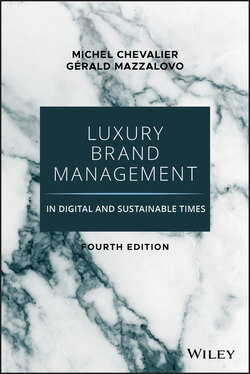Читать книгу Luxury Brand Management in Digital and Sustainable Times - Michel Chevalier - Страница 54
The Social and Cultural Environment
ОглавлениеThis ethical and aesthetic dimension has another effect. It places the luxury industry in the realm of the arts and into the cultural trends of the moment. As it looks for new shapes, colors, feelings, or modes of consumption, this industry is much more a part of the cultural scene than any others. Thus, its advertising bypasses traditional processes and looks for a special aesthetic environment and a special artistic connivance with its consumer target. In this, luxury products must function as a cultural mirror.
Keeping Up with Social Trends. The importance of staying in touch with changing social trends is reflected in the experiences of some of the leading brands themselves. For example, at one time the sexy-chic positioning of Gucci met with strong approval from its target customer. Versace, too, was doing very well with the sexiness of its dresses and in its communication. Today the sexy-chic theme seems to be less attractive to the consumer, and Gucci has come to a much more classic and probably much younger and much more colorful positioning. Versace, however, failed to read the mood in the same way and didn't change, with the result that its sales fell considerably until the turnaround came from very sophisticated women's cocktail dresses and men's suits.
Paco Rabanne, with his glittering metallic dresses, was an icon of the spirit of sexual liberation that was all-pervasive around 1968 and met with strong interest from the public. Jane Fonda and Brigitte Bardot had special gowns made for them as a special commitment to a given way of life. Fashion magazines were showing his models and interviewing him for his views on the new social trends. At that time, his point of view mattered to the public. Today, though, few would be interested in his thoughts on what is happening in the world.
In using a luxury product, the consumer is making a claim to being different and special, at the forefront of social trends rather than appearing to be outside of society.
This fit with social trends and the spirit of the time is a very strong aspect of luxury. When people longed for a return to nature and a simpler society, they loved Danish designer Per Spook, who was designing natural-looking heavy wool-knit jackets and beige cotton skirts. When they wanted an extremely sexy look, they went for Versace. When the times become more traditional and conservative, with the emphasis on the mature woman, Chanel has a lot to offer.
With hindsight, it is clear that some brands have developed very quickly at one time and then declined, and not necessarily because their management was less effective and their marketing was off-base. It was simply a product of the changing times. Now, of course, good marketing is supposed to remain in line with consumer trends. But how far should a company go to adjust its product and brand positioning to the changes in society?
The Response to Changing Trends. As mentioned earlier, Paco Rabanne's appeal faded when his philosophy was deemed to be out of step with changing social trends that saw the advent of the sexy society of the late 1990s. He could have come to a sexy positioning and, indeed, many of the sophisticated metallic dresses of Versace could have been done by him. But this was not his style and he did not feel the need to do it.
Salvatore Ferragamo provides another interesting case. It developed from high-quality shoes to producing the finest silk ties and scarves on the market. A Ferragamo tie is immediately identifiable by its beautiful colors and its extremely fine prints, which could almost have come from an old Persian manuscript. But, now, the fashion is for plain jacquard silk ties. Should Salvatore Ferragamo change its product philosophy? The fact is that it has indeed introduced some jacquard silk ties, but the company is struggling to differentiate itself from its competitors.
We finish this section with a note to remind managers of the underlying uncertainty of the luxury business. Often, success (or the lack of it) is as much a product of the changing social environment as it is of individual managerial style.
